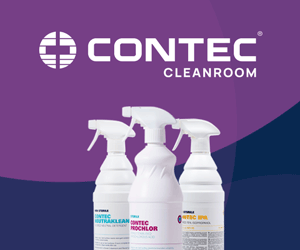In 1937, Hellmuth Walter, an engineer and pioneer in the use of hydrogen peroxide in rocket systems, brought his findings to scientists who went on to create the ‘wonder weapon’ used in World War II to kill tens of thousands of Europeans. Some 80 years later, and the chemical compound used to propel V-2 rockets is now being used in new technology that will help drug manufacturers ensure product quality and ultimately patient safety.
UK company ChargePoint Technology is using a hydrogen peroxide vapour cycle in split butterfly valve devices. Its AseptiSafe transfer system produces a classified area the size of a dinner plate and its very compact size means that the need for the highest classification cleanrooms and isolators is reduced.
A revolutionary leap has been made in modern biotech and the thinking behind it is, in fact, rocket science. Hydrogen peroxide, which has the chemical formula H2O2, became a vital component in engineering during World War II when scientists were charged with creating technology superior to that used by Germany’s enemies. It was the use of hydrogen peroxide as a fuel that led to huge technological advancement in warfare, flight, propelled vehicles, space exploration and now in the 21st century – bio-technology.
ChargePoint Technology is in the vanguard of its new application. The gas is applied as small droplets which are dropped onto a hot plate and vaporised and then blown into an air stream and into a sealed space between the passive and active discs just before the valve docks and that is when the elimination of bacteria in the area takes place. Once the sealed chamber has been created the hydrogen peroxide gas is flushed through to decontaminate the space. The decontamination process is then validated with the use of biological indicators.
Cleaning validation
Biological indicators holding one million spores are placed inside the chamber, then the hydrogen peroxide gas is flushed through to kill them. The biological indicator is then removed and tested to see if any of the spores have survived and will grow from it. If no spores grow we then know that the process has worked and the unwanted microbes have been killed; the area is contaminant-free, proving our patented system works.
There is a powerful connotation in the use of hydrogen peroxide in our valves because we know that they are making the pharma industry safer and this means that more drugs can be manufactured more quickly, which leads to better treatment and more lives being saved.
The use of hydrogen peroxide as a disinfectant is widespread but its use in cutting edge cleanroom technology is moving its uses on.
It is a versatile chemical; as well as being a propellant to fire rockets, it is a powerful antiseptic and disinfectant and a powerful immune system booster – the human body even makes use of it to kill viruses, bacteria and dispel toxins. As well as hydrogen peroxide’s natural power, it has also been used as an ingredient to solve everything from teeth whitening, contact lens cleaning, mouthwash, tackling acne and even cleaning aquariums.
In the 1980s, after almost a century of use of aqueous hydrogen peroxide for disinfecting heat sensitive medical devices and surgical apparatuses, the American Sterilizer Company, (now STERIS) discovered H2O2 has a quicker sporicidal action time when in vapour form in smaller concentrations.
Hydrogen peroxide vapour (HVP) has for the past 20 years given fast and safe decontamination to areas that may be contaminated with bacteria with its application in isolators and cleanrooms.
ChargePoint Technology launched its AseptiSafe valve in 2015. Its patented decontamination cycle sterilises areas using a product solution not seen before. It brings about a fully validated approach to the removal of potential contamination which allows the surrounding cleanroom grade to be reduced. This has massive commercial and production benefits.
It is being acknowledged by pharma industry giants who have installed the valves in their manufacturing plants from the US to China that the device is a one-of-a-kind, efficient bio-decontamination valve.
Speeding vaccine production
The company is leading the way in designing innovative technology to ensure vital drugs from biological sources, such as vaccines, are manufactured quickly and safely.
Last month, economist Lord Jim O’Neill published the findings of his extensive investigation into the burgeoning global problem of anti-microbial resistance (AMR). Among a raft of action points, Lord O’Neill urged health organisations and Big Pharma to promote the use of vaccines as an alternative to the spread of drug resistance and to improve the levels of cleanliness in hospitals and other breeding grounds where infections can be spread.
The development of new vaccines is believed to be the key to fighting AMR. Lord O’Neill has recommended a US$2bn Global Innovation Fund for early stage research and paying companies a huge $1bn prize for creating new antibiotics.
Superbugs are currently responsible for almost one million deaths a year in the world and by 2050 around 10 million people could die each year – which is one person every three seconds. Evolution in the pharmaceutical industry is happening but production innovation is lagging behind R&D and solutions are required urgently. Because ChargePoint Technology’s device ensures more efficient and cost effective expedition of vaccines to market, it could help in the battle to prevent the AMR issue which is having a potentially huge impact on humanity.
In terms of cost comparison, use of the device can lead to substantial savings. Construction of a Grade B cleanroom with Grade A manipulations can cost upwards of $860k with annual running costs of $150k – while with AseptiSafe and a Grade C cleanroom costs are as low as $110k with $3.6k annual running cost.
The company’s customers in the US include pharma heavyweights such as Merck, Roche, Genentech, Johnson & Johnson, Ritedose and Pfizer. Around 20% of its annual revenue comes from the US. However, global superpower China has an interest in this technology as it eyes up the prize of being leader in the pharma market, not just in the East but in the West too. The Chinese pharma industry has made drug quality a priority in order to comply with the US Food and Drug Administration’s (FDA) strict health and safety rules. By adhering to GMP and export standards, it is predicted that China will become a leader in the manufacturer of pharmaceuticals brought to market in the not-too-distant future.
Science and engineering within biotech has reinvented technology from the past to make advancements that will save rather than destroy humanity. The question now is whether Big Pharma will change in time.

Christian Dunne – Global Product Group Manager, Aseptic at ChargePoint Technology




